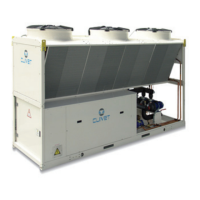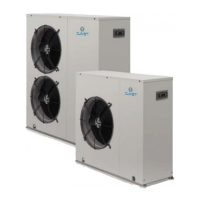Do you have a question about the CLIVET WSAN-XSC 502 and is the answer not in the manual?
Details about the unit's identification label, including type, serial number, and manufacturer data.
Importance of the serial number for unique identification and tracing unit features and parts.
Risks associated with incorrect installation, site selection, and securing the unit.
Potential hazards like burning smells, smoke, accidental contact, and improper maintenance.
Hazards related to electrical connections, power supply, and grounding.
Procedures for checking the unit for damage or deficiencies upon delivery.
Safe operations for moving and lifting the unit, considering critical points.
Key considerations for installing air-conditioning systems, including spaces and connections.
Required spaces for unit operation, maintenance, and operator safety.
Prevention measures against freezing in water connections, using glycol or heating cables.
Requirements for water quality, filtration, and flow switch for exchanger protection.
Schematic illustrating recommended components and connections for the water circuit.
Management of condensation during winter operation, including potential freezing issues.
General requirements for designing and performing electrical installations.
Technical electrical specifications for standard units, including current and power ratings.
Step-by-step guide for connecting the unit to the main power supply.
Essential checks before unit startup, including installation and power supply.
Checking the refrigerating circuit for oil stains, leaks, and correct pressure.
Verifying screw tightening, grounding, panel positioning, and voltage.
Monitoring operational parameters like pressures and temperatures for unit control.
Emphasis on identifying and eliminating the cause before resetting alarms.
Procedures to visualize active, historical, and stored alarms.
Possible causes for high pressure alarms, such as high temperatures or dirty coils.
Possible causes for low pressure alarms, like low temperatures or insufficient flow.
Identifying and resolving issues related to faulty probes.
Identifying and resolving issues with faulty pressure transducers.
Common reasons for compressor protection activation, such as high discharge temperature.
Procedures for safely disconnecting the unit, including refrigerant recovery.
Guidelines for dismantling and disposing of the unit via authorized centers.











